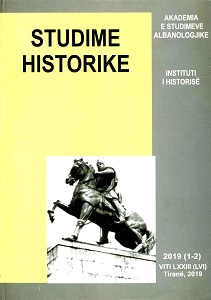KONTRIBUTII ARKEOLOGJISË NË IDENTIFIKIMIN E FORTIFIKIMEVE TË PERIUDHËS SË SKËNDERBEUT NË RAJONIN E DIBRËS
NEW ARCHAEOLOGICAL DATA ON SOME UNKNOWN SKANDERBEG'S FORTIFICATIONS IN DLBRA REGION
Author(s): Adem BunguriSubject(s): Archaeology, Architecture, Social history
Published by: Qendra e Studimeve Albanologjike
Keywords: Skanderbeg's fortifications In Dlbra Region; history; archaeology; fortification, Architecture;
Summary/Abstract: Koxhaxhik’s castle lies at Zhupa area, between Dibra and Struga, in the eastern edge of Dibra area (FYROM). It was located at the top of a very rocking crest among the villages Koxhaxhik on southeast and Breshtan on northwest. Its altitude is 1160m above the sea level, whereas its relative height is 360m. It has a very strategic favourable position, easy controlling the road Ohër-Dibër through the Drini i Zi valley. This is a very important road, which join the two most important transbalkanic roman vias: the ancient via Egnatia on the south (Ohrid basin) and the Lissus-Naissus on the north (Kukës basin). Being the northern branch of via Egnatia, Drini i Zi road was the very strategic corridor through the prehistoric times to nowdays. At Koxhaxhik’s castle there are some traces of' its inhabitation since the late bronze age and early iron age, as well as the late antiquity period and the mediaval ones. There are some parts of its late antiquity period and medieval ones fortification system, on the upper platform of its even rocking surface, at the so-called “citadel”. Its even surface has a polygonal plan with perimeter 145m, 58m long and 34m wide, and a surface nearly 1600m2. The surrounding walls follow the lines of the crest, except the southern side, including inside of the defensed surface two narrow tarraces with good dwelling conditions. The surrounding wall used the defense abilities of the rocking crest, somewhere including in its structure the natural rocks, or interrupting itself where its slopes are rocky or very steep ones. The nowdays wall’s remains consist by 7 tracts of the surrounding walls, respectively 2.00m, 3.50m, 6.00m, 2.10m, 9.00 m, 6.00m and 22m long and its seeing perimeter 50.60m. The wall of the Late antiquity period is actually the earliest fortification of Koxhaxhik’s castle. We could see it in the outer line wall of its tower. It had been builded with river and natural stones related with limestones mortar, by opus incertum technique. The castle had nearly been refortificated in medieval period, fulfilling the damaged parts and rebuilding the new ones lines of them. To the Medieval period belong all the remains tracts, named A-G, 50.60m long in generally, including the outer second wall of the its tower. Their height moves from 1.00m to 2.50-3.00m, whereas their width moves from 1.40 to 1.70m. A similar width of surrounding walls have already been seen in some other medieval castles of Albania, such as the castle of Kruja, Shurdhahu(near Scodra), Daula (Kurbin), Stelushi(Dibër-Mat), Guri i Bardhë (Petralba) etc. In the chronological viewpoint, the medieval fortification of Koxhaxhik’s castle belong to the XIV-XV centuries A.D. To this period Materiale shkencore dhe kumtesa 249 conform the technique of building ofthe surrounding walls, their narrow width, the tecniques features of the mortar determinated by the limestones, the using of the iron building scaffold etc.To the medieval preosman period of the XIVXV centuries A.D. belong nearly all the the fragments of vessels founded on this castle and its varosh.There are a prevalence of the kitchen vessels with brown and brown to black colour clay, with good baking towards the sparse table ones with cleaner clay in ocra or light red colour, sometimes decorated in white geometric painting. The similar forms of vessels have been discovered in some other medieval castles, such as at the castle of Stelush, Petrela, Daula, Kruja etc. The new archaeological data confirm that this castle had been inhabitated since the LBA and the EIA. It had been fortificated with surrounding walls for the first time at the late antiquity period, whereas at the medieval ones, probably at XIV-XV centuries A.D it had been refortificated. This period was the most intensed life ones on this castle and its varosh. The above mentinoned archaeological and historical arguments make us to believe that the wellknown medieval town of Sfetigrade can be identified in the Koxhaxhik’s castle and its varosh. Skanderebeg’s tower at Vajkal is without doubt another strong argument to support the identification of Vajkal in Vajkal. The archaeological data presented briefly above, proves that the fortifications in Dibra region was increased especially during the XIV-XV cent. AD. The accuracy of Barlet’s descriptions is confirmed by the archaeological surveys as well as by the historical geography und the identiphication of Scanderbeg’s fortifications and his battles’ places locations. We hope that the archaeological information presented here, would be helpful to enrich our knowledge on the archaeological data about the Skanderbeg’s fortifications in Dibra region. We need to correct the subjective and voluntarist viewpoints, published in our historical literature, e.g. about the Koxhaxhik and Modrica’s castles, as well as Vajkal’s location.
Journal: Studime Historike
- Issue Year: 2019
- Issue No: 01-02
- Page Range: 205-253
- Page Count: 49
- Language: Albanian
- Content File-PDF

